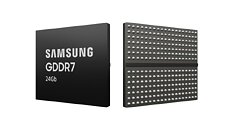- Joined
- Oct 9, 2007
- Messages
- 47,637 (7.44/day)
- Location
- Dublin, Ireland
| System Name | RBMK-1000 |
|---|---|
| Processor | AMD Ryzen 7 5700G |
| Motherboard | Gigabyte B550 AORUS Elite V2 |
| Cooling | DeepCool Gammax L240 V2 |
| Memory | 2x 16GB DDR4-3200 |
| Video Card(s) | Galax RTX 4070 Ti EX |
| Storage | Samsung 990 1TB |
| Display(s) | BenQ 1440p 60 Hz 27-inch |
| Case | Corsair Carbide 100R |
| Audio Device(s) | ASUS SupremeFX S1220A |
| Power Supply | Cooler Master MWE Gold 650W |
| Mouse | ASUS ROG Strix Impact |
| Keyboard | Gamdias Hermes E2 |
| Software | Windows 11 Pro |
Samsung Electronics, the world leader in advanced memory technology, today announced it has developed the industry's first 24-gigabit (Gb) GDDR7 DRAM. In addition to the industry's highest capacity, the GDDR7 features the fastest speed, positioning itself as the optimum solution for next-generation applications. With its high capacity and powerful performance, the 24 Gb GDDR7 will be widely utilized in various fields that require high-performance memory solutions, such as data centers and AI workstations, extending beyond the traditional applications of graphics DRAM in graphics cards, gaming consoles and autonomous driving.
"After developing the industry's first 16 Gb GDDR7 last year, Samsung has reinforced its technological leadership in the graphics DRAM market with this latest achievement," said YongCheol Bae, Executive Vice President of Memory Product Planning at Samsung Electronics. "We will continue to lead the graphics DRAM market by bringing next-generation products that align with the growing needs of the AI market." The 24 Gb GDDR7 utilizes 5th-generation 10-nanometer (nm)-class DRAM, which enables cell density to increase by 50% while maintaining the same package size as the predecessor.

In addition to the advanced process node, three-level Pulse-Amplitude Modulation (PAM3) signaling is used to help achieve the industry-leading speed for graphics DRAM of 40 gigabits-per-second (Gbps), a 25% improvement over the previous version. The GDDR7's performance can be further enhanced to up to 42.5 Gbps, depending on the usage environment.
Power efficiency is also enhanced by applying technologies that were previously used in mobile products to graphics DRAM for the first time. By implementing methods like clock control management and dual VDD design, unnecessary power consumption can be significantly reduced, leading to an improvement of over 30% in power efficiency.
To boost operational stability during high-speed operations, the 24 Gb GDDR7 minimizes current leakage by using power gating design techniques.
Validation for the 24 Gb GDDR7 in next-generation AI computing systems from major GPU customers will begin this year, with plans for commercialization early next year.
View at TechPowerUp Main Site
"After developing the industry's first 16 Gb GDDR7 last year, Samsung has reinforced its technological leadership in the graphics DRAM market with this latest achievement," said YongCheol Bae, Executive Vice President of Memory Product Planning at Samsung Electronics. "We will continue to lead the graphics DRAM market by bringing next-generation products that align with the growing needs of the AI market." The 24 Gb GDDR7 utilizes 5th-generation 10-nanometer (nm)-class DRAM, which enables cell density to increase by 50% while maintaining the same package size as the predecessor.

In addition to the advanced process node, three-level Pulse-Amplitude Modulation (PAM3) signaling is used to help achieve the industry-leading speed for graphics DRAM of 40 gigabits-per-second (Gbps), a 25% improvement over the previous version. The GDDR7's performance can be further enhanced to up to 42.5 Gbps, depending on the usage environment.
Power efficiency is also enhanced by applying technologies that were previously used in mobile products to graphics DRAM for the first time. By implementing methods like clock control management and dual VDD design, unnecessary power consumption can be significantly reduced, leading to an improvement of over 30% in power efficiency.
To boost operational stability during high-speed operations, the 24 Gb GDDR7 minimizes current leakage by using power gating design techniques.
Validation for the 24 Gb GDDR7 in next-generation AI computing systems from major GPU customers will begin this year, with plans for commercialization early next year.
View at TechPowerUp Main Site





